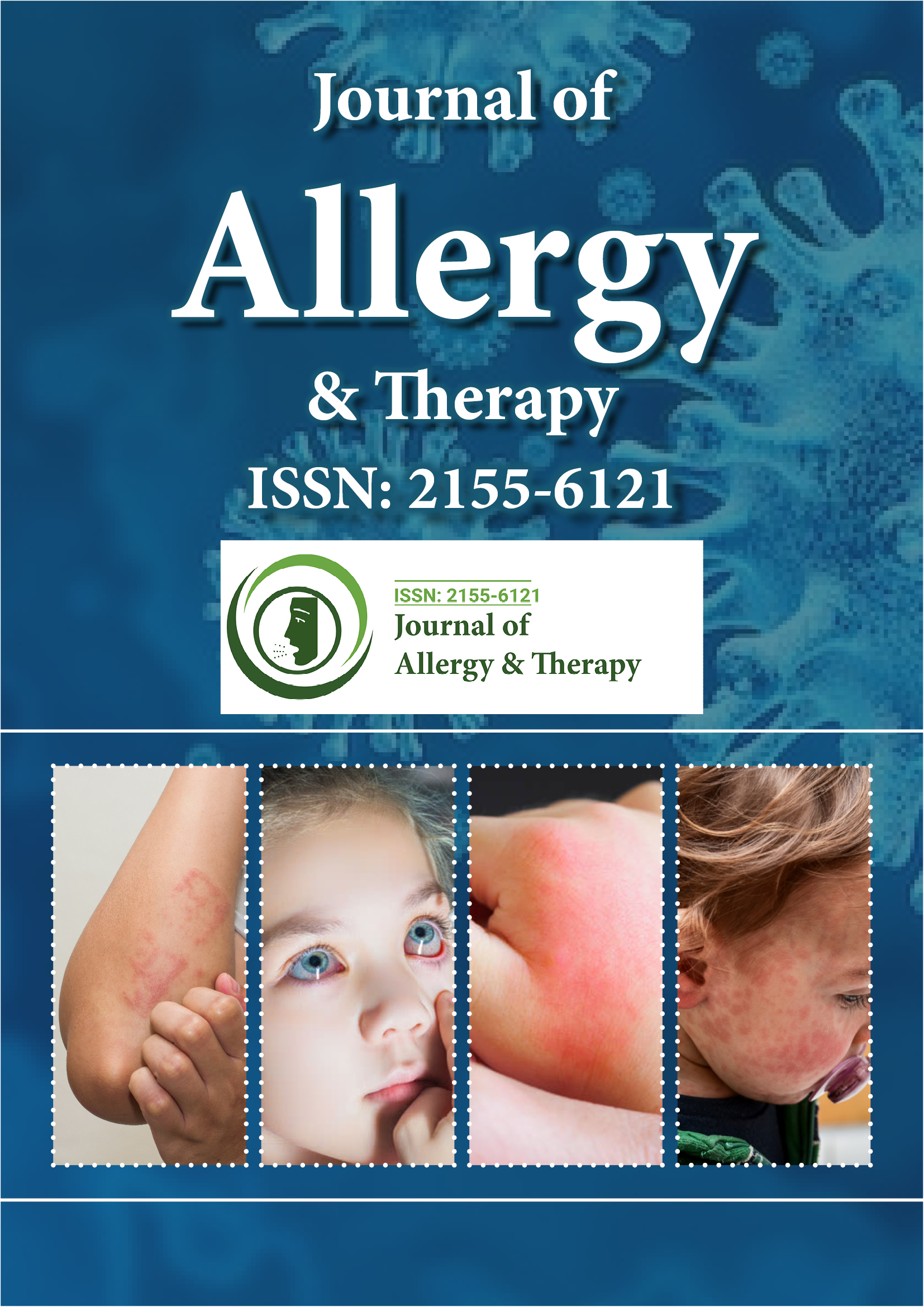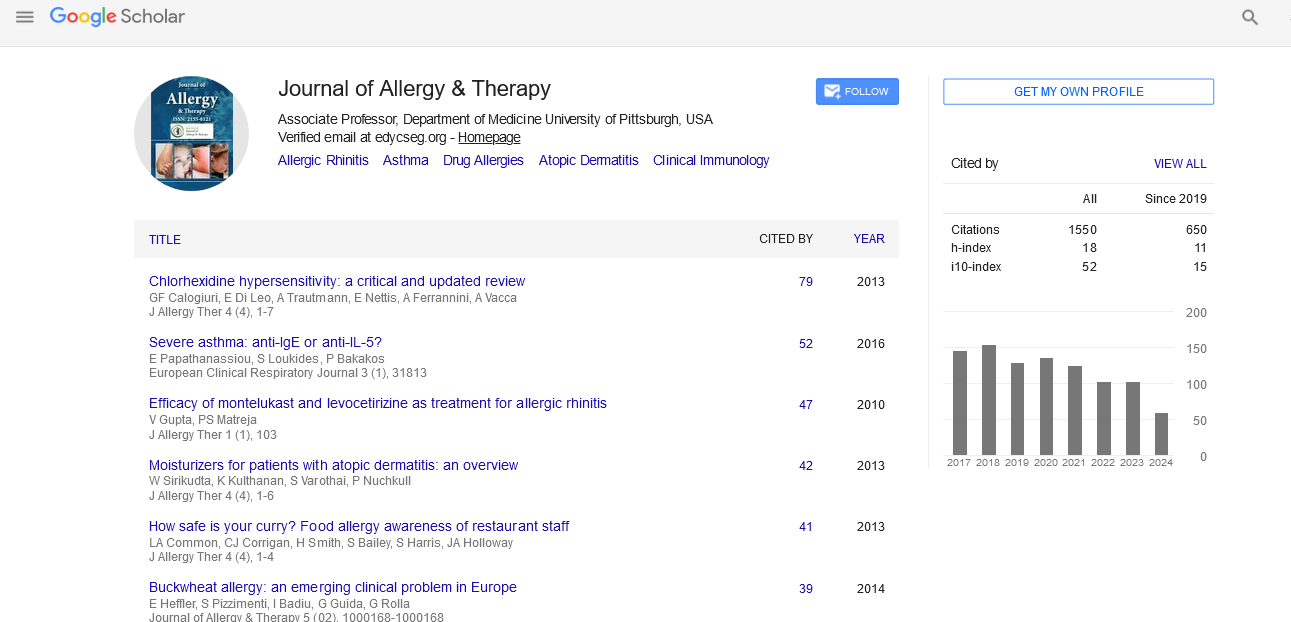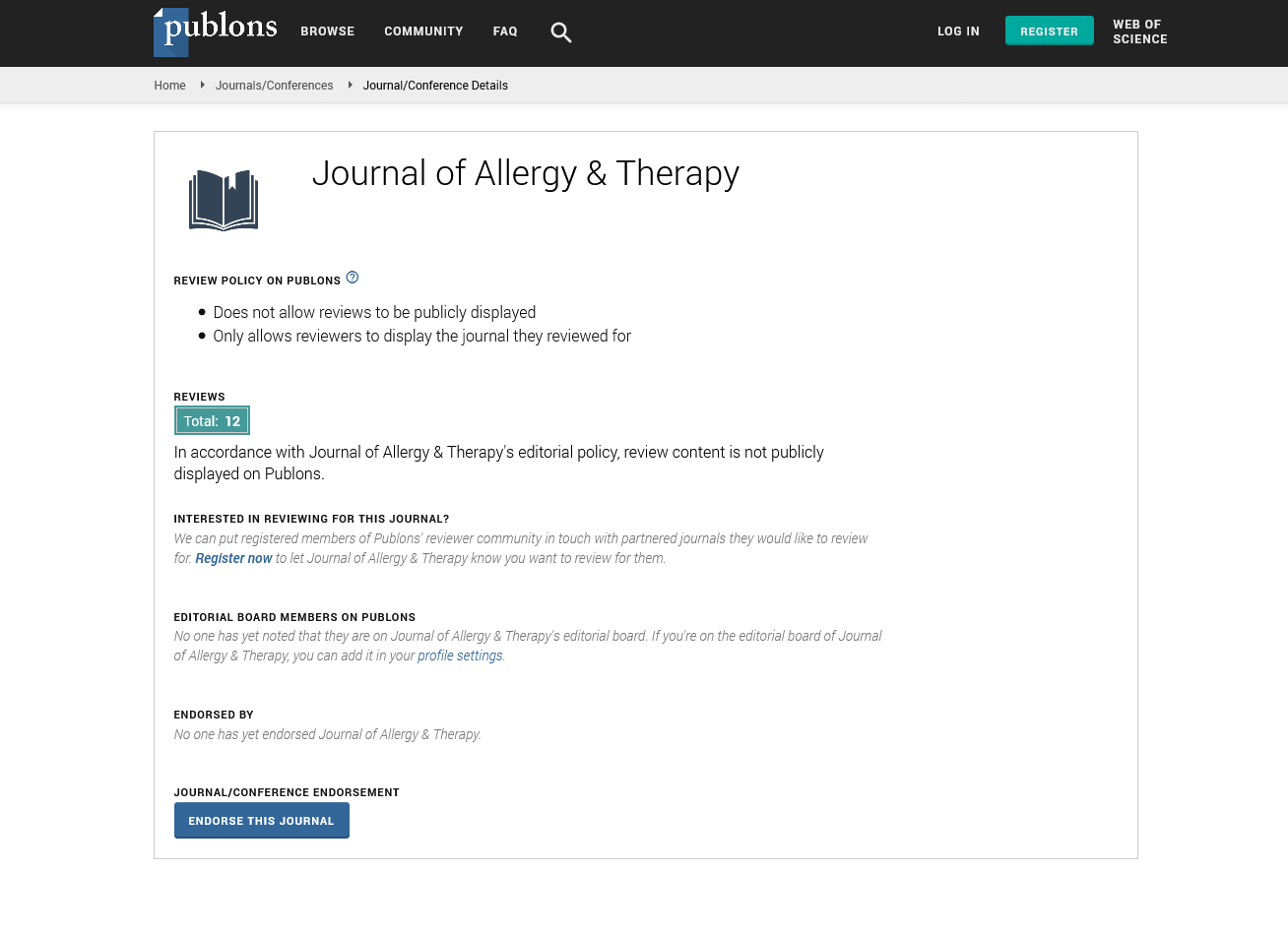Indexed In
- Academic Journals Database
- Open J Gate
- Genamics JournalSeek
- Academic Keys
- JournalTOCs
- China National Knowledge Infrastructure (CNKI)
- Ulrich's Periodicals Directory
- Electronic Journals Library
- RefSeek
- Hamdard University
- EBSCO A-Z
- OCLC- WorldCat
- SWB online catalog
- Virtual Library of Biology (vifabio)
- Publons
- Geneva Foundation for Medical Education and Research
- Euro Pub
- Google Scholar
Useful Links
Share This Page
Journal Flyer

Open Access Journals
- Agri and Aquaculture
- Biochemistry
- Bioinformatics & Systems Biology
- Business & Management
- Chemistry
- Clinical Sciences
- Engineering
- Food & Nutrition
- General Science
- Genetics & Molecular Biology
- Immunology & Microbiology
- Medical Sciences
- Neuroscience & Psychology
- Nursing & Health Care
- Pharmaceutical Sciences
Opinion Article - (2025) Volume 16, Issue 2
: Understanding Food Allergies: Triggers, Symptoms, Diagnosis, Management, and Preventive Approaches Worldwide
Riccardo Castagnoli*Received: 30-Apr-2025, Manuscript No. JAT-25-29453; Editor assigned: 02-May-2025, Pre QC No. JAT-25-29453; Reviewed: 16-May-2025, QC No. JAT-25-29453; Revised: 23-May-2025, Manuscript No. JAT-25-29453; Published: 30-May-2025, DOI: 10.35248/2155-6121.25.16.424
Description
Food allergy is a serious and potentially life-threatening condition in which the body’s immune system reacts abnormally to certain foods. Unlike food intolerance, which is generally less severe and does not involve the immune system, food allergy can trigger rapid, intense responses even with minute exposures to the allergen. These reactions occur when the immune system mistakenly identifies a specific protein in food as harmful and mounts a defense against it by releasing histamine and other chemicals, leading to a wide range of symptoms that can affect multiple organs.
Food allergies can develop at any age but are most common in infants and young children. While some children may outgrow their allergies over time, others continue to be allergic into adulthood. The most common food allergens often referred to as the "big eight" include milk, eggs, peanuts, tree nuts, soy, wheat, fish and shellfish. These eight categories account for the majority of allergic reactions worldwide, though regional differences exist depending on dietary patterns and genetic factors.
The symptoms of a food allergy can vary in severity and onset, occurring within minutes to several hours after exposure. Mild symptoms may include hives, itching, swelling of the lips or face, stomach cramps, nausea, or vomiting. More severe reactions can involve wheezing, difficulty breathing, drop in blood pressure, or anaphylaxis—a medical emergency that requires immediate treatment with epinephrine. Anaphylaxis can be fatal if not treated promptly and individuals at risk are often advised to carry an epinephrine auto-injector for emergency use.
Diagnosis of food allergy begins with a detailed medical history and documentation of symptoms related to specific food exposures. Healthcare providers may recommend an elimination diet, in which suspected allergens are removed from the diet and then gradually reintroduced under medical supervision. Skin prick tests and blood tests measuring specific antibodies can help identify sensitization to certain allergens. However, these tests are not always definitive and an oral food challenge—the gold standard for diagnosis—may be necessary. This test involves consuming small amounts of the suspected allergen under medical observation to monitor for reactions.
Management of food allergies relies heavily on strict avoidance of the identified allergen. This includes reading food labels meticulously, inquiring about ingredients when eating out and being cautious about cross-contamination during food preparation. In some cases, hidden ingredients or trace amounts of allergens can cause reactions, making vigilance essential. Individuals with severe allergies should also have an emergency action plan in place and inform caregivers, teachers, or colleagues about their condition.
Education plays a critical role in managing food allergies safely. Patients and their families must learn how to recognize symptoms, use medications like antihistamines or epinephrine and respond appropriately to an emergency. Schools, restaurants, airlines and other public institutions increasingly implement policies to accommodate individuals with food allergies, although consistency and enforcement vary across regions. Public awareness campaigns and food labeling laws have also helped reduce accidental exposures and increase safety.
Recent advances in research have led to new approaches for treating food allergies. Oral Immunotherapy (OIT) is one such method, in which small but gradually increasing amounts of the allergenic food are administered to build tolerance. OIT has shown promise, particularly in peanut allergy, by desensitizing individuals enough to prevent severe reactions from accidental exposures. However, it is not without risks and should be conducted under strict medical supervision. Epicutaneous and sublingual immunotherapies are also under investigation, offering alternative routes with potentially fewer side effects.
The rise in food allergies over recent decades, particularly in developed countries, has prompted numerous studies exploring possible causes. Factors such as genetics, environmental exposures, microbiome diversity, vitamin D deficiency and dietary patterns are believed to influence the development of allergies. The "hygiene hypothesis" suggests that reduced exposure to microbes during early childhood may impair immune system development and increase the risk of allergic conditions. Similarly, delayed introduction of allergenic foods was once recommended for infants, but newer guidelines now suggest that early introduction, especially of peanut and egg, may help prevent the development of allergies in high-risk infants.
Food allergies not only affect physical health but also impose significant emotional and psychological stress. Constant vigilance and fear of accidental exposure can lead to anxiety, social isolation and reduced quality of life. Children may feel excluded at school events or parties, while adults may face challenges in travel, dining, or romantic relationships. Support groups, counseling and educational resources can help individuals and families cope with the emotional burden of living with food allergies.
Globally, food allergy remains a growing public health concern. Differences in diagnosis, treatment access and food labeling regulations highlight disparities between countries. In low and middle-income regions, food allergies may be underdiagnosed or mismanaged due to limited healthcare infrastructure. International collaboration among researchers, healthcare providers, policymakers and advocacy organizations is essential to address the global impact of food allergy and to promote equitable access to care, education and emerging treatments.
Conclusion
In conclusion, food allergy is a complex and serious condition that requires comprehensive management, informed awareness and ongoing research. Through accurate diagnosis, avoidance strategies, emergency preparedness and promising new therapies, individuals with food allergies can lead safe, fulfilling lives. As science continues to unravel the underlying mechanisms of allergy and tolerance, there is hope for better treatments, preventive strategies and eventually, long-term solutions that may reduce the burden of food allergy for future generations.
Citation: Castagnoli R (2025) Understanding Food Allergies: Triggers, Symptoms, Diagnosis, Management and Preventive Approaches Worldwide. J Allergy Ther. 16:424.
Copyright: © 2025 Castagnoli R. This is an open-access article distributed under the terms of the Creative Commons Attribution License, which permits unrestricted use, distribution and reproduction in any medium, provided the original author and source are credited.


